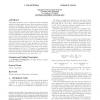Free Online Productivity Tools
i2Speak
i2Symbol
i2OCR
iTex2Img
iWeb2Print
iWeb2Shot
i2Type
iPdf2Split
iPdf2Merge
i2Bopomofo
i2Arabic
i2Style
i2Image
i2PDF
iLatex2Rtf
Sci2ools
GECCO
2009
Springer
2009
Springer
Partial neighborhoods of elementary landscapes
This paper introduces a new component based model that makes it relatively simple to prove that certain types of landscapes are elementary. We use the model to reconstruct proofs for the Traveling Salesman Problem, Graph Coloring and Min-Cut Graph Partitioning. The same model is then used to efficiently compute the average values over particular partial neighborhoods for these same problems. For Graph Coloring and Min-Cut Graph Partitioning, this computation can be used to focus search on those moves that are most likely to yield an improving move, ignoring moves that cannot yield an improving move. Let x be a candidate solution with objective function value f(x). The mean value of the objective function over the entire landscape is denoted ¯f. Normally in an elementary landscape one can only be sure that a neighborhood includes an improving move (assuming minimization) if f(x) > ¯f. However, by computing the expected value of an appropriate partial neighborhood it is sometimes p...
Artificial Intelligence | GECCO 2009 | Graph Coloring | Min-Cut Graph Partitioning | Partial Neighborhood |
| Added | 26 May 2010 |
| Updated | 26 May 2010 |
| Type | Conference |
| Year | 2009 |
| Where | GECCO |
| Authors | L. Darrell Whitley, Andrew M. Sutton |
Comments (0)

